Talk about the shot of a lifetime! A Canadian airline passenger waiting on the tarmac at JFK this morning got an incredible view of the shuttle Enterprise landing! Just…wow.
Video by YouTube user “daujla2”. (Hat tip to the New York Post.)
Talk about the shot of a lifetime! A Canadian airline passenger waiting on the tarmac at JFK this morning got an incredible view of the shuttle Enterprise landing! Just…wow.
Video by YouTube user “daujla2”. (Hat tip to the New York Post.)
[/caption]
Icons of America are captured together in a fantastic photo by NASA photographer Bill Ingalls, taken on the morning of April 27, 2012 from Jersey City, NJ. The Statue of Liberty, the Empire State Building… and Enterprise, the first space shuttle, seen as it was ferried toward its eventual new home at the Intrepid Sea, Air and Space Museum.
After several days of delays due to weather, the SCA with mounted Enterprise took off from Washington Dulles International Airport this morning.
Watch a video of Enterprise flying over New York here.
Enterprise was the first shuttle built for NASA. It was used to conduct test flights in the atmosphere and never flew into space, yet the data gathered from its experimental flights were integral to the development of the shuttle program.
Originally housed at the Smithsonian’s Steven F. Udvar-Hazy Center, Enterprise will be demated from the SCA (Shuttle Carrier Aircraft) and placed on a barge that will travel on a 2-day trip up the Hudson to the Intrepid Museum on June 4.
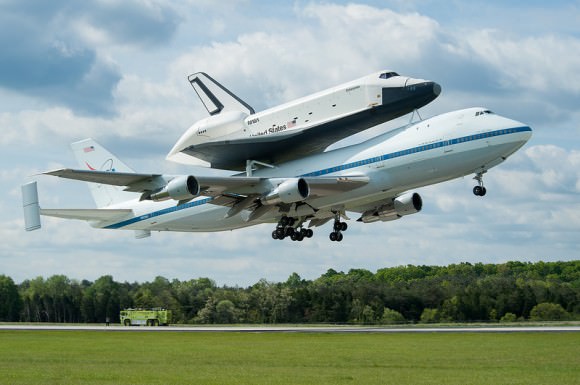

Enterprise will open for display to the public on July 19.
See more details on the Intrepid Museum’s website.
[/caption]
Saturn’s curious moon Phoebe features a heavily-cratered shape and orbits the ringed planet backwards at a considerable distance of over 8 million miles (12.8 million km). According to recent news from the Cassini mission Phoebe may actually be a Kuiper Belt object, having more in common with planets than it does with any of Saturn’s other satellites.
132 miles (212 km) in diameter, Phoebe is the largest of Saturn’s irregular moons — a cloud of small, rocky worlds held in distant orbits at highly inclined paths. Its backwards (retrograde) motion around Saturn and dense composition are dead giveaways that it didn’t form in situ within the Saturnian system, but rather was captured at some point when it strayed too close to the gas giant.
In fact it’s now thought that Phoebe may be a remnant from the formation of the Solar System — a planetesimal — with its own unique history predating its adoption into Saturn’s extended family of moons.
“Unlike primitive bodies such as comets, Phoebe appears to have actively evolved for a time before it stalled out,” said Julie Castillo-Rogez, a planetary scientist at NASA’s Jet Propulsion Laboratory. “Objects like Phoebe are thought to have condensed very quickly. Hence, they represent building blocks of planets. They give scientists clues about what conditions were like around the time of the birth of planets and their moons.”
Although Phoebe is heavily eroded and irregularly-shaped today at one time it may have been much rounder. But an early composition of radioactive elements would have generated heat, and as it warmed it “deflated” through compression, growing denser and denser.
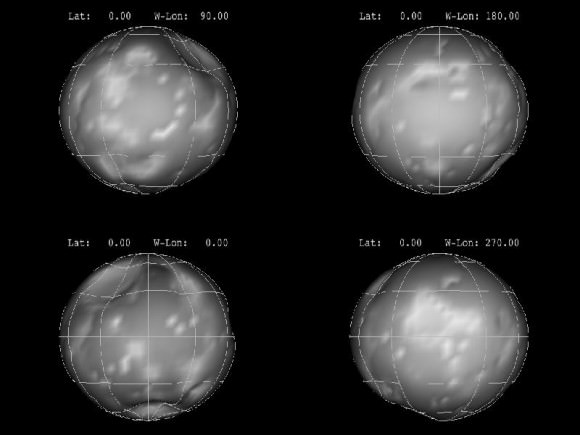
Now, Phoebe exhibits a similar density to Pluto — another denizen of the Kuiper Belt.
At some point Phoebe may even have had water, kept liquid by its radioactive heat. That is, until the heat faded and it froze, creating the icy surface detected by Cassini’s instruments.
Still, Cassini’s study of Saturn’s moons has provided scientists with clues to what was happening much earlier on in the Solar System. What caused Phoebe to drift inwards to be caught up in orbit around Saturn? How did it survive such a supposed shuffling of planets and other worlds did not? As Cassini continues its investigation answers — and undoubtedly even more questions — will be uncovered.
Read more on NASA’s news release here.
Image: NASA/JPL/SSI. Color composition by Gordan Ugarkovic.
Here on Universe Today we often discuss things that exist on the atomic and sub-atmonic scale. Even though astronomy is concerned with very big things that happen over very, very large distances and time spans, the reality is that our Universe is driven by events occurring on the tiny atomic scale.
We all know atoms are really small (and the particles inside them are even smaller.) But… how small are they, really? To help answer that question, here’s a neat little animation from TEDEducation, presented by Jonathan Bergmann and Cognitive Media.
(That’s one big grapefruit!)
[/caption]
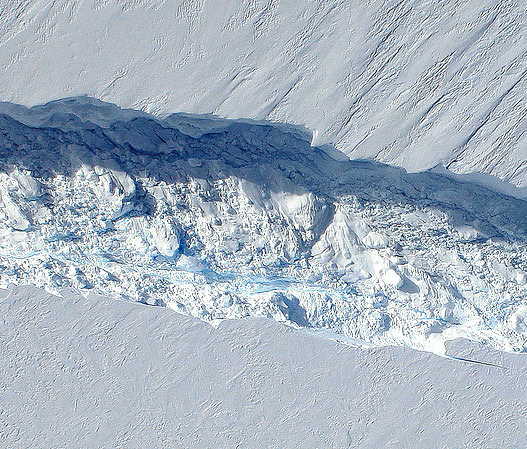
Data collected from a NASA ice-watching satellite reveal that the vast ice shelves extending from the shores of western Antarctica are being eaten away from underneath by ocean currents, which have been growing warmer even faster than the air above.
The animation above shows the circulation of ocean currents around the western Antarctic ice shelves. The shelf thickness is indicated by the color; red is thicker (greater than 550 meters), while blue is thinner (less than 200 meters).
Launched in January 2003, NASA’s ICESat (Ice, Cloud and land Elevation Satellite) studied the changing mass and thickness of Antarctica’s ice from its location in polar orbit. An international research team used over 4.5 million surface height measurements collected by ICESat’s GLAS (Geoscience Laser Altimeter System) instrument from Oct. 2005 to 2008. They concluded that 20 of the 54 shelves studied — nearly half — were losing thickness from underneath.
[/caption]
Most of the melting ice shelves are located in west Antarctica, where the flow of inland glaciers to the sea has also been accelerating — an effect that can be compounded by thinning ice shelves which, when grounded to the offshore seabed, serve as dams to hold glaciers back.
Melting of ice by ocean currents can occur even when air temperature remains cold, maintaining a steady process of ice loss — and eventually increased sea level rise.
“We can lose an awful lot of ice to the sea without ever having summers warm enough to make the snow on top of the glaciers melt,” said Hamish Pritchard of the British Antarctic Survey in Cambridge and the study’s lead author . “The oceans can do all the work from below.”
The study also found that Antarctica’s winds are shifting in response to climate change.
“This has affected the strength and direction of ocean currents,” Pritchard said. “As a result warm water is funnelled beneath the floating ice. These studies and our new results suggest Antarctica’s glaciers are responding rapidly to a changing climate.”
ICESat completed operations in 2010 and was decommissioned in August of that year. Its successor ICESat-2 is anticipated to launch in 2016.
Read more on NASA’s news release here.
Animation credit: NASA/Goddard CGI Lab
[/caption]
The Sombrero galaxy has a split personalty, according to recent observations by NASA’s Spitzer Space Telescope. Infrared imaging has revealed a hazy elliptical halo of stars enveloping a dual-structured inner disk; before this, the Sombrero galaxy was thought to be only disk-shaped.
Spitzer’s heat-seeking abilities reveal both stars and dust within the Sombrero galaxy, also known as Messier 104 and NGC 4594. The starlight detected at 3.5 and 4.6 microns is represented in blue-green while the dust imaged at 8.0 microns is shown in red.
In addition, Spitzer discerned that the flat disk within the galaxy is made up of two sections — an inner disk composed almost entirely of stars with no dust, and an outer ring containing both dust and stars.
The galaxy’s dual personality couldn’t be so clearly seen in previous visible-light images.
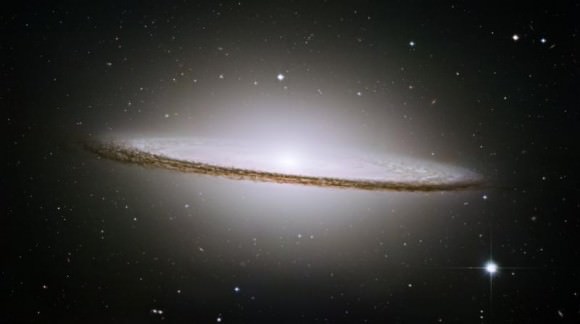
“The Sombrero is more complex than previously thought,” said Dimitri Gadotti of the European Southern Observatory in Chile and lead author of the report. “The only way to understand all we know about this galaxy is to think of it as two galaxies, one inside the other.”
Although it might seem that the Sombrero is the result of a collision between two separate galaxies, that’s actually not thought to be the case. Such an event would have destroyed the disk structure that’s seen today; instead, it’s thought that the Sombrero accumulated a lot of extra gas billions of years ago when the Universe was populated with large clouds of gas and dust. The extra gas fell into orbit around the galaxy, eventually spinning into a flattened disk and forming new stars.
This is one of the first galaxies to be seen with such a dual structure — even though M104 has been known about since the mid-1700s.
“Spitzer is helping to unravel secrets behind an object that has been imaged thousands of times,” said Sean Carey of NASA’s Spitzer Science Center at CalTech. “It is intriguing Spitzer can read the fossil record of events that occurred billions of years ago within this beautiful and archetypal galaxy.”
At a magnitude of +8, the Sombrero galaxy is just beyond the limit of naked-eye visibility but can be seen with small telescopes (4-inch/100 mm or larger). It is 28 million light-years away and can be found in the night sky located 11.5° west of Spica and 5.5° northeast of Eta Corvi.
Read more on the NASA press release here.
NASA’s Lunar Reconnaissance Orbiter (LRO) made a low pass over the Apollo 16 site last fall, capturing images of the leftovers from John Young and Charlie Duke’s 1972 exploration of the Descartes Highlands. The video above takes us on a tour of the Apollo 16 site from lunar orbit, and includes audio from the original communications and some very nice comparative photos and video clips showing the same features from ground level.
The goal of Apollo 16 was to explore for the first time a lunar highlands location, and collect samples of what were initially thought to be volcanic rocks. The rocks were believed to be of a different material than what was collected during previous missions.
As it turned out, the rocks collected by Duke and Young weren’t volcanic in origin at all; they ended up being breccias — cemented-together chunks ejected from ancient cratering events hundreds of miles away.
Apollo 16 also set up various experiment packages to study lunar geology, magnetism and the solar wind. The Lunar Roving Vehicle (LRV) allowed Young and Duke to travel across a much wider area than they would have otherwise been able to on foot. It was the second mission to use an LRV, and the rover — as well as its tracks — are still there today, looking exactly as they did when they were left 40 years ago.
[/caption]
The Apollo 16 ascent stage lifted off from the lunar surface on the evening of April 23, 1972 and docked with the Command Module containing Ken Mattingly. The following day the astronauts began their trip back to Earth, completing the 250,000-mile traverse three days later on April 27.
The Moon would be visited again in December of that same year during Apollo 17, the last mission of the program and the last time that humans would walk on the surface of another world. Now, 40 years later, satellites orbiting the Moon take pictures of what was left behind by these historic events. Perhaps someday soon the sites will be visited from ground level… maybe even by a new generation of astronauts.
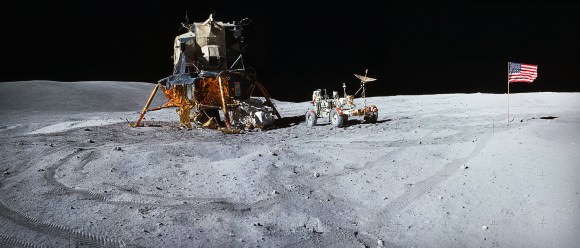
Read more about this on Arizona State University’s LROC site, and explore the full-frame Narrow-Angle Camera image from the LROC here.
Video: NASA/GSFC/Arizona State University
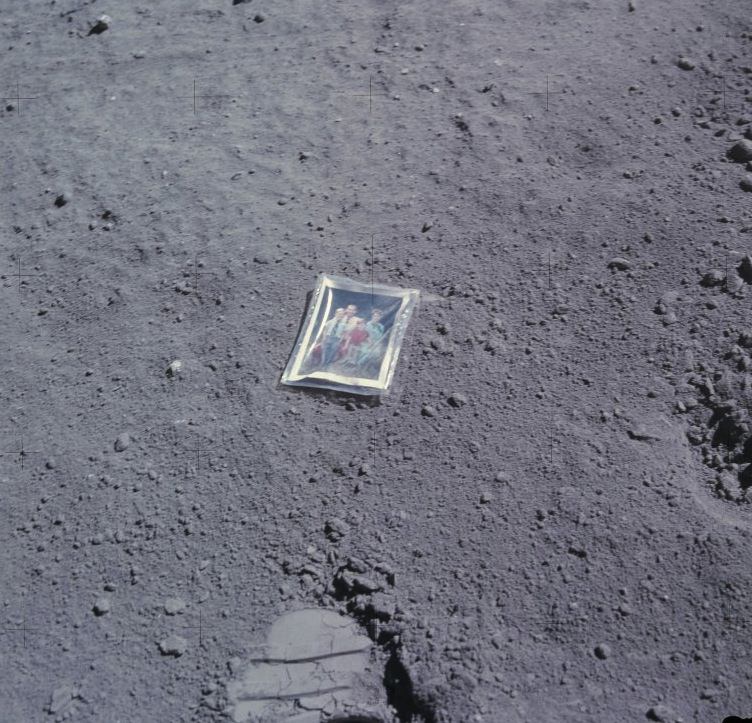
[/caption]
Well, the family photo, anyway.
On April 23, 1972, Apollo 16 astronauts Charlie Duke and John Young embarked on the third and final EVA of the mission, exploring the Descartes Highlands via Lunar Roving Vehicle. During the EVA, before setting up a Solar Wind Collector, Duke placed a small family photo he had brought along onto the lunar surface and snapped a few photos of it with his Hasselblad film camera. This is one of the photos.
The portrait shows Charlie, his wife Dorothy, and their two sons Charles and Thomas. It looks like they are sitting on a bench in the summertime.
The family photo, gingerly wrapped in clear plastic and slightly crumpled from being stashed in the pocket of a space suit, was left on the Moon. It presumably still sits there today, just inches away from Charlie’s boot print — which, presumably, is also there.
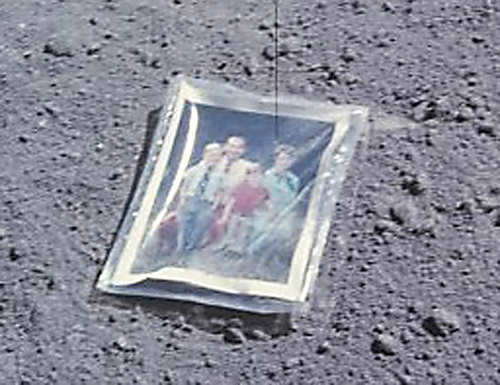
At the time of this writing it’s been exactly 40 years to the day that this photo was taken.
Image: NASA/JSC scan
I came across this image while looking through the Project Apollo Image Archive for some relevant images from the Apollo 16 mission. Amid scans of Hasselblad photos showing lunar samples, experiments and scenes from LRV jaunts, which are all fascinating in their own right, I came across this poignant image and couldn’t resist sharing it. To know that a family photo is resting upon the surface of another world is nothing short of amazing… while the missions to the Moon were a testament to human endeavor, it’s small things like this that remind us of the people that made it all possible.
On December 24, 1968, Apollo 8 astronauts Frank Borman, William Anders and Jim Lovell were the first humans to witness an Earthrise as our home planet came up over the lunar horizon. The photos they captured were the first of their kind, instantly inspiring the imaginations of millions and highlighting the beauty and fragility of our world.
Now, NASA has used modern satellite data to recreate the scenes that the Apollo 8 astronauts saw 44 years ago and combined them with their historic photographs to present a new “Earthrise”… version 2.0.
Created in recognition of Earth Day 2012, the Earthrise animation was made from data acquired by NASA’s Lunar Reconnaissance Orbiter’s laser altimeter, as well as the Moderate Resolution Imaging Spectroradiometer (MODIS) on the Terra Earth-observing satellite.
“This visualization recreates for everyone the wondrous experience of seeing Earth from that privileged viewpoint,” says LRO Project Scientist Rich Vondrak of NASA’s Goddard Space Flight Center.
Animator Ernie Wright recreated the scene using Apollo mission reports and photos taken by the crew. The audio is a recording of original communication from the astronauts.
[/caption]
“I think the one overwhelming emotion that we had was when we saw the earth rising in the distance over the lunar landscape… it makes us realize that we all do exist on one small globe. For from 230,000 miles away it really is a small planet.”
— Frank Borman, Apollo 8 Commander
Read the release on the NASA LRO site here.
Video: NASA/GSFC
As thanks for enjoying his new album while in orbit, William Shatner recorded a special message for the crew of Expedition 30 aboard the International Space Station. Famous for his role as the brash captain of the USS Enterprise, Shatner sent up this short-but-sweet subspace packet earlier today.
[/caption]
“Seeking Major Tom”, Shatner’s 4th studio album, contains 20 space-related songs recorded by Shatner as well as many other artists, like Sheryl Crow, Lyle Lovett and Peter Frampton. By pure coincidence it contains many favorites of the Expedition 30 crew and has hit the top of the low-Earth orbit charts.
The album was released in October 2011, just before the launch of André Kuipers, Oleg Kononenko and Don Pettit.
After all, what’s the final frontier without a little music to go with it?
“Sometimes a feeling is all we humans have to go on.”
– Captain James T. Kirk, A Taste of Armageddon (Star Trek: The Original Series)
Video courtesy of William Shatner